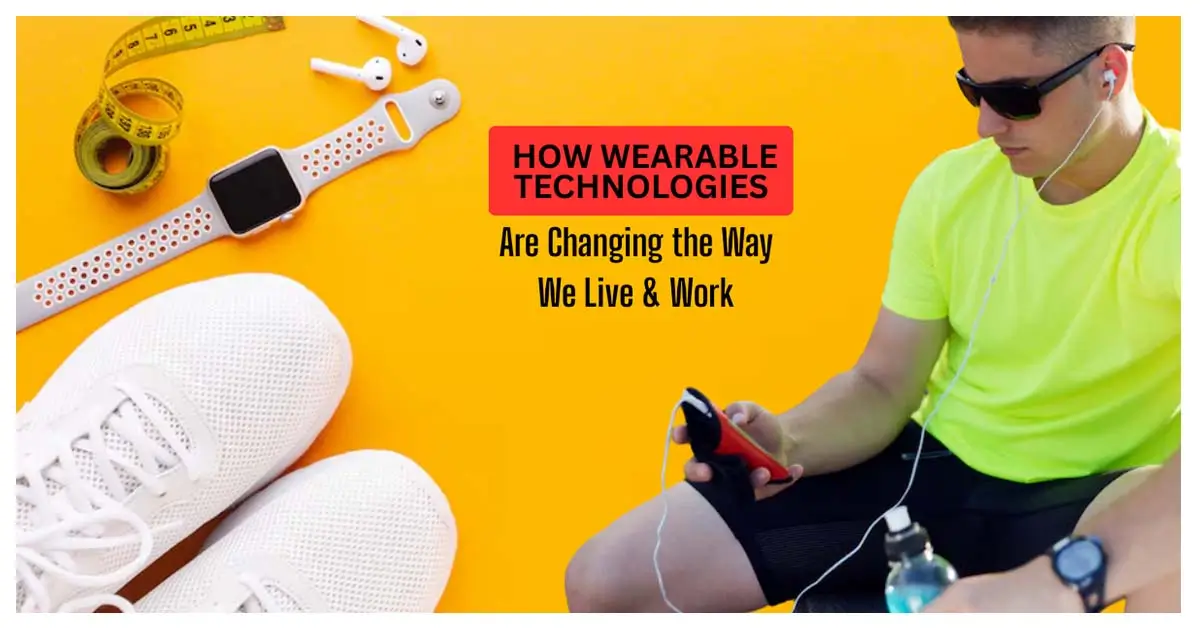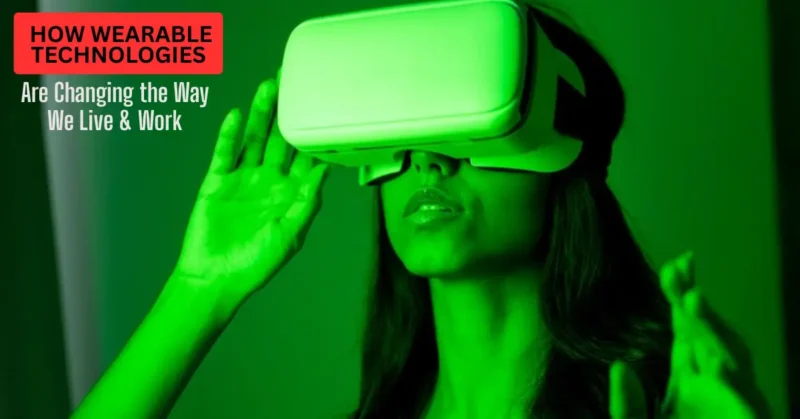Uncover how Wearable Technologies are changing Our Lives and Work. Examine how innovative wearables influence health, productivity, and daily living.
Thank you for reading this post, don't forget to subscribe!How Wearable Technologies are Changing The Way of Our Lives
Wearable technologies are rapidly transforming our approach to healthcare. Today, millions of people use wearables—once considered mere novelties—to manage chronic diseases, monitor their physical activity, and monitor their health.
These devices can collect a wide range of data, including heart rate, blood pressure, sleep patterns, activity levels, and even stress levels. This information can help identify potential health issues early on, track progress over time, and support informed decisions regarding lifestyle changes.
Wearable technology is transforming preventive healthcare in the following ways:
Monitoring Chronic Conditions
Wearable devices are crucial in managing chronic health conditions such as diabetes, heart disease, and asthma. By continuously monitoring vital signs and personal health metrics, these innovative devices empower patients to take control of their health.
For instance, a smart wearable can provide real-time alerts when blood sugar levels fluctuate beyond safe limits or when a patient’s heart rate deviates from the normal range, whether it becomes dangerously high or unusually low. This immediate feedback helps individuals stay vigilant about their health status and collaborate more effectively with their healthcare providers to adjust treatment plans as needed.
Detecting Diseases Early
Wearable devices can also detect diseases when they are most treatable. For example, a wearable device can monitor changes in skin pigmentation that could indicate skin cancer or changes in heart rhythm that could indicate a heart condition. Wearable devices are crucial in early disease detection, allowing for timely intervention when conditions are most treatable.
For instance, a sophisticated wearable device can continuously monitor subtle changes in skin pigmentation, which may serve as early warning signs of skin cancer. Similarly, these devices can track fluctuations in heart rhythm, alerting users to potential heart conditions before they escalate. This proactive approach to health monitoring empowers individuals to take charge of their well-being and seek medical advice at the first sign of concern.
Promoting Healthy Behaviors
Wearable technology plays a vital role in fostering healthy habits that encompass exercise, restorative sleep, and effective stress management. A fitness tracker monitors daily step counts and provides real-time feedback, motivating individuals to increase physical activity and reach their fitness goals. In another instance, a smartwatch might track sleep patterns, analyze data to identify trends and offer personalized insights and advice to help improve sleep quality, ensuring a more restful and rejuvenating night.
Personalized Healthcare
Wearable devices play a significant role in personalizing healthcare by continuously monitoring various aspects of an individual’s health, such as heart rate, activity levels, and sleep patterns. This wealth of data empowers healthcare providers to craft tailored treatment plans that address each patient’s unique needs and circumstances. Additionally, by analyzing the gathered information, doctors can more accurately assess a person’s risk of developing specific diseases, enabling early intervention and proactive management of health conditions.
Wearable Devices: Transforming Healthcare Through Continuous Monitoring
The following are some examples of how wearable technology is being used in preventive healthcare today:
Apple Watch
The Apple Watch has some features that can be used for preventive healthcare, including:
- Heart Rate Monitoring: The Apple Watch can continuously track heart rate, which can help identify signs of potential health problems such as atrial fibrillation, heart failure, and anemia.
- Blood Pressure Monitoring: The Apple Watch uses photoplethysmography (PPG) to assess blood pressure. Although it is still in development, this feature has the potential to give consumers important information about their blood pressure levels.
- Sleep Tracking: The Apple Watch can track sleep patterns, including sleep duration, stages, and respiratory rate. This information can help identify sleep disorders like insomnia and sleep apnea.
- Activity Tracking: The Apple Watch can track activity levels, including steps taken, distance traveled, and calories burned. This information can be used to assess overall fitness levels and track progress.
Fitbit
Fitbit devices offer features similar to those of Apple Watch, including heart rate monitoring, sleep tracking, and activity tracking. In addition, some Fitbit devices also offer features such as:
- Stress Monitoring: The HRV measures the variation in time between heartbeats. A lower HRV is typically associated with higher levels of stress.
- SpO2 Monitoring: Some Fitbit devices can measure blood oxygen levels (SpO2), which measure the blood’s oxygen transport capacity. Low SpO2 levels can indicate many health problems, including respiratory infections, asthma, and heart disease.
- Dexcom G6: The Dexcom G6 is a continuous glucose monitor (CGM) that people with diabetes can use to track their blood sugar levels throughout the day and night. It comprises a tiny sensor inserted under the skin and a transmitter worn on the body. The sensor continuously measures blood sugar levels and transmits the data to the transmitter, which then sends the data to a smartphone or receiver.
The Dexcom G6 can identify trends in blood sugar levels and track the effects of food, exercise, and medication on them. Informed decisions regarding diabetes management can help prevent complications such as hypoglycemia (low blood sugar) and hyperglycemia (high blood sugar).
Oura Ring
The Oura Ring is a bright ring that tracks sleep patterns, activity levels, and heart rate variability. The Oura Ring also tracks body temperature and menstrual cycles.
The Oura Ring can identify trends in health data and track the effects of lifestyle changes on overall health. This information can help you make informed decisions about how to boost energy levels, reduce stress, and improve sleep quality.
Smart Clothing
Recent advancements in textile technology have given birth to an exciting new realm in wearable tech—clothing embedded with advanced sensors. These innovative garments blend seamlessly into everyday attire, making it easy for individuals to integrate technology into their lives.
With their sleek designs and vibrant colors, they not only make a fashion statement but also offer a discreet and continuous monitoring experience, tracking vital health metrics and lifestyle data without drawing attention. This fusion of fashion and technology paves the way for a smarter, more connected future.
-
Monitoring Physiological Parameters
Lively and colorful clothing embedded with advanced woven sensors actively monitors crucial physiological parameters such as heart rate, body temperature, and muscle activity. This innovative approach to health monitoring enables real-time tracking of vital signs, providing a thorough and nuanced understanding of an individual’s well-being.
By seamlessly integrating this data with the information typically collected by traditional wearables, it creates a more comprehensive picture of health, empowering users to make informed decisions about their physical condition.
-
Enhancing Everyday Integration
The integration of technology into clothing enhances the everyday integration of wearables. Individuals can enjoy the benefits of health monitoring without needing additional devices, making it an appealing option for those who value subtlety and convenience.
The Future of Wearable Technology
The future of wearable technology is bright. As technology advances, we expect more sophisticated wearable devices to track health, monitor chronic conditions, and promote healthy behaviors. As technology improves, we can expect more advanced wearables to track fitness, monitor chronic diseases, and promote healthy behaviors. Here are a few trends that we can expect to see in the future of wearable technology:
-
More Miniaturized and Discreet Devices
Wearable devices are already becoming smaller and more sensitive. Ultimately, we can expect to see wearable devices that are so small and lightweight that we barely even notice we are wearing them.
-
More Integrated Devices
Wearable devices are also becoming more integrated with other devices, such as smartphones and smart speakers. We can expect wearable devices to seamlessly interact with other devices to provide a more comprehensive and personalized healthcare experience.
-
More Advanced Sensors
Wearable devices are already equipped with various sensors to collect data about our health and activity levels. In the future, we can expect to see wearable devices with even more advanced sensors that can manage more accurate and detailed data about our health.
More Personalized Insights
As wearable devices collect more data about our health and activity levels, they will be able to provide us with more customized insights about our health and well-being. Using this information, we can make informed health and fitness decisions.
Here are some potential future uses for wearable technology:
- Wearable devices could detect early signs of cancer or other diseases. Patients could benefit from earlier diagnosis and treatment.
- Using wearable devices for chronic disease monitoring would be beneficial. This could assist clinicians in modifying treatment regimens as necessary to guarantee that patients receive the best care possible.
- Wearable devices could provide real-time feedback on workouts and other activities. By following the appropriate techniques, people can maximize the effectiveness of their physical movements and reduce the risk of injury.
- Wearable devices could integrate with other healthcare technologies, such as electronic health records (EHRs). Doctors can make better care decisions with a complete view of a patient’s health.
- Wearable technology has the potential to revolutionize preventive healthcare, but it also faces some challenges and limitations.
Challenges and limitations of wearable technology
Some of the challenges and limitations of wearable technology include:
-
Reliability and Accuracy
Several variables may impact wearable technology, including the environment, sensor placement, and calibration. As a result, more accurate and reliable data readings may arise.
-
Data Privacy and Security
Wearable devices collect sensitive data about our health and activity levels. This data is vulnerable to hacking and other cyber threats.
-
Cost
Wearable technology may prove pricey, particularly for high-end models with cutting-edge capabilities. Such could make them inaccessible to certain people.
User Acceptance
Some people may hesitate to wear wearable devices due to privacy concerns, discomfort, or inconvenience.Despite these challenges and limitations, wearable technology has the potential to play a significant role in preventive healthcare. Addressing the challenges and limitations can make wearable technology more accurate, reliable, affordable, and user-friendly.
Solutions to the Challenges and limitations of wearable technology
There are several possible solutions to the challenges and limitations of wearable technology.
-
Accuracy and Reliability
Manufacturers can improve the accuracy and reliability of wearable devices by using better sensors, developing more sophisticated data processing algorithms, and conducting rigorous testing.
-
Data Privacy and Security
Manufacturers can improve data privacy and security by implementing strong security measures like encryption and authentication. Users can additionally exercise more control over the collection and usage of data.
-
Cost
Manufacturers can reduce the cost of wearable devices by making them more efficient to produce and offering a more comprehensive range of devices at different price points.
-
User Acceptance
Manufacturers can improve user acceptance by designing wearable devices that are more comfortable, convenient, and stylish. They can also educate users about the benefits of wearable technology and how to use it safely and effectively.
Frequently Asked Questions
Q. What are the challenges of wearable devices?
Wearable devices face several significant challenges that must be addressed to ensure their successful adoption and effectiveness. One major issue is the accuracy and reliability of the data they collect. Users rely on these devices to provide precise information about their health and activity levels so that any inaccuracies can lead to misinformation and a lack of trust.
Another critical concern is the security of user data. As wearable devices often collect sensitive personal information, robust security measures are essential to protect this data from unauthorized access and breaches. Users need to feel confident that their privacy is safeguarded.
Cost is also a significant factor that affects the widespread adoption of wearable technology. Many potential users may find the price of these devices prohibitive, which can limit their accessibility and use among different demographics.
Finally, gaining widespread user acceptance involves addressing potential user skepticism and educating consumers about the benefits and features of wearable devices. Successful integration into daily life requires demonstrating their value and usability so that more people will embrace this technology.
Q. What are the weaknesses of wearable technology?
Wearable technology faces several challenges that limit its effectiveness and user experience. One significant issue is the short battery life, which often requires users to recharge their devices frequently, disrupting their convenience.
Additionally, many wearables come with a limited range of features, hindering their appeal and functionality for users seeking more comprehensive capabilities. Lastly, there is a crucial need for interoperability among different devices; seamless communication and compatibility between various wearable devices and platforms are essential for an enhanced user experience and to maximize the technology’s potential.
Q. How does wearable technology maintain good health?
Wearable technology plays a significant role in helping individuals maintain their health and well-being by offering various features designed to monitor and enhance daily activities. These devices, such as smartwatches and fitness trackers, track physical activity by recording steps taken, calories burned, and even exercise intensity. Additionally, they monitor sleep quality by analyzing sleep patterns, duration, and disturbances, providing valuable insights that can improve rest and recovery.
Furthermore, many wearable devices offer real-time data on health metrics such as heart rate, blood pressure, and oxygen levels, enabling users to make informed decisions about their fitness routines and overall health. By integrating this technology into daily life, individuals can better understand their physical condition and take proactive steps toward achieving their health goals.
Q. What are the five benefits of wearable technology?
Wearable technology offers many advantages that can significantly enhance our daily lives. Firstly, it promotes improved health and fitness by enabling users to monitor their physical activity, heart rate, and sleep patterns, encouraging a more active lifestyle. Secondly, it boosts productivity by allowing individuals to receive notifications, manage tasks, and track their time efficiently, all from their wrists.
Additionally, wearable devices can help reduce stress levels by providing mindfulness and relaxation features, such as breathing exercises or guided meditations. Furthermore, they enhance safety by offering features like location tracking and emergency alerts, which can be crucial in critical situations. Lastly, wearables facilitate better communication and connectivity, allowing users to stay in touch with others effortlessly, receive calls, and send messages without needing to reach for their phones.
Q. How will wearables change the world?
Wearable technology has the potential to revolutionize our lives in numerous ways. To encourage individuals to adopt healthier lifestyles, these devices can track fitness levels, monitor vital signs, and provide personalized feedback to motivate users toward better health choices. Furthermore, wearables can boost productivity by offering tools for time management and task organization, helping users stay focused and efficient throughout their day.
In addition to promoting well-being and efficiency, these devices can play a crucial role in reducing stress. Features like mindfulness reminders and stress tracking can empower users to manage their mental health proactively. Moreover, wearables enhance safety by providing emergency alerts, fall detection, and location tracking, ensuring that help is just a moment away when needed.
Lastly, wearables facilitate innovative ways of staying connected and informed. With notifications, communication apps, and access to information right at one’s fingertips, users can maintain relationships and stay engaged with the world around them more effortlessly than ever before. Wearables are not just devices; they symbolize a transformative shift in our daily routines and interactions.
Read more articles on Health and Wellness Tips
You may like to read:






